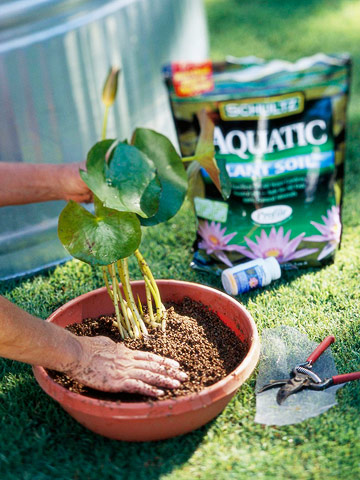
Planting Tips
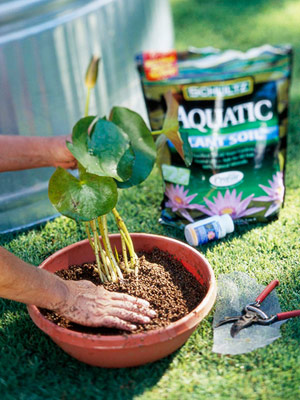
Some water garden plants grow in containers submerged beneath the surface of the water. Others float directly on the surface. Yet others grow in moist soil around the edge of the pond. A well-designed water garden uses a combination of these types of plants.
Water Lilies and Submerged Plants
Water lilies and lotuses are the jewels of the water garden with their spectacular colorful blooms. Grow them in submerged containers. Place the water lily container so that it is submerged 6 to 36 inches below the water level. Permeable mesh pots or containers made of landscape fabric are often used for planting water lilies, although plastic pots work well, too. Avoid using regular potting soil — it will float out of the container. Instead, use a good water-garden potting mix. Lotus needs a large container because its rhizomes spread rapidly.
Click here for more on planting water lilies.
continue reading below
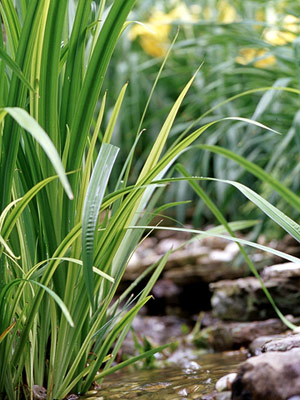
Water’s Edge Plants
Plant varieties such as sweet flag, marsh marigold, lobelia, rush, pickerel weed, and cat tail, that have roots that grow in wet soil directly in the ground at the edge of a clay-lined pond. If your water garden has a plastic liner, pot the plants in plastic nursery containers and place them in the pond with just the base of the container submerged.
Learn about more water garden features with our guide.
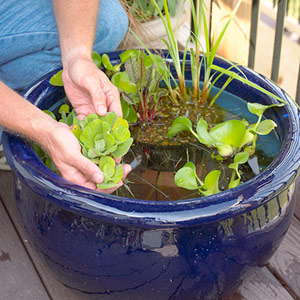
Floating Plants
Floating plants are the ultimate in easy-care gardening. There’s no potting necessary — just set them in the water, and they’ll float on the surface. In warm-winter climates, some floating plants can become invasive, so check local regulations about which varieties you can grow.
Water Garden Care Tips
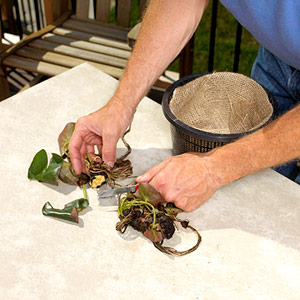
Remove spent flowers, yellowing foliage, and excess plant growth. If floating plants multiply to cover more than 60 percent of the pond’s surface, pull out and compost the excess foliage. Divide overgrown water lilies and other aquatic plants early in the season.
In autumn, you may wish to cover the water garden with netting to prevent leaves from collecting in the pond. If leaves do blow into the water, remove them to prevent them from tying up oxygen as they decompose.
Maintenance
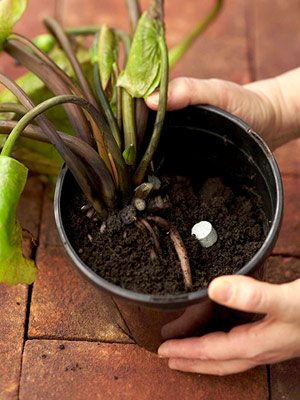
Algae build up can become a problem in water gardens. Barley straw or pellets placed in a pond or stream in spring prevents algae growth. A good filter or clarifier also prevents development of algae. Use a fountain or waterfall to keep the water aerated and ward-off foul-smelling bacteria.
Watering aquatic plants couldn’t be easier. Simply maintain the pond level at the correct depth so plants at the water’s edge don’t dry out and so that roots of submerged plants remain covered. Refill your water feature before the water level drops several inches. Automate the process by installing a float valve that automatically turns on the water when the level drops to a set point and shuts off when full.
Floating plants derive their nutrition directly from the water. Water lilies and other containerized plants, however, often need fertilization to grow and bloom well. Several types of commercial water garden fertilizer pellets are available. Place these directly into the potting soil of container plants.
Watering

Watering aquatic plants couldn’t be easier. Simply maintain the pond level at the correct depth so plants at the water’s edge don’t dry out and so that roots of submerged plants remain covered. Refill your water feature before the water level drops several inches. Automate the process by installing a float valve that automatically turns on the water when the level drops to a set point and shuts off when full.
Feeding

Floating plants derive their nutrition directly from the water. Water lilies and other containerized plants, however, often need fertilization to grow and bloom well. Several types of commercial water garden fertilizer pellets are available. Place these directly into the potting soil of container plants.
SOURCE:http://www.bhg.com/gardening/landscaping-projects/water-gardens/water-garden-care-guide/